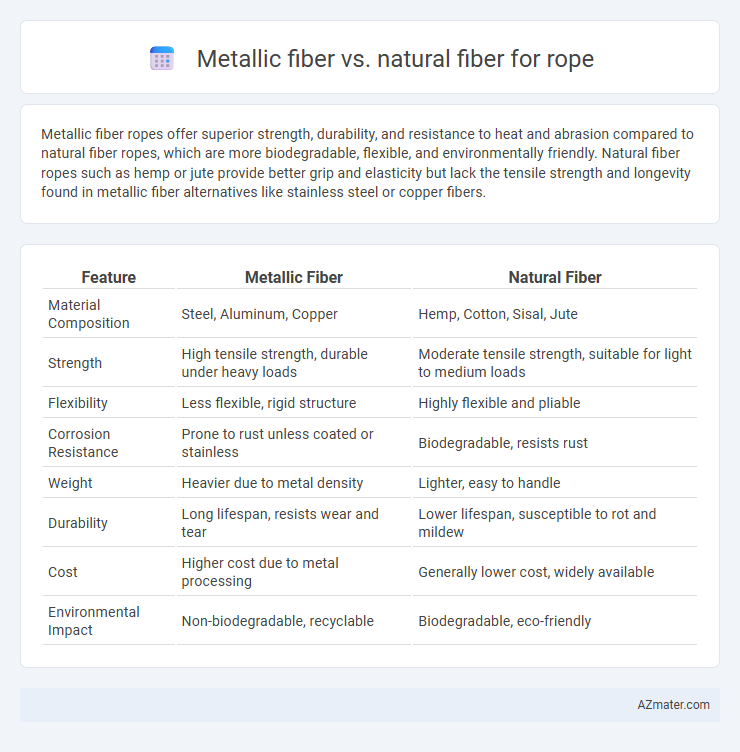Metallic fiber ropes offer superior strength, durability, and resistance to heat and abrasion compared to natural fiber ropes, which are more biodegradable, flexible, and environmentally friendly. Natural fiber ropes such as hemp or jute provide better grip and elasticity but lack the tensile strength and longevity found in metallic fiber alternatives like stainless steel or copper fibers.
Table of Comparison
| Feature | Metallic Fiber | Natural Fiber |
|---|---|---|
| Material Composition | Steel, Aluminum, Copper | Hemp, Cotton, Sisal, Jute |
| Strength | High tensile strength, durable under heavy loads | Moderate tensile strength, suitable for light to medium loads |
| Flexibility | Less flexible, rigid structure | Highly flexible and pliable |
| Corrosion Resistance | Prone to rust unless coated or stainless | Biodegradable, resists rust |
| Weight | Heavier due to metal density | Lighter, easy to handle |
| Durability | Long lifespan, resists wear and tear | Lower lifespan, susceptible to rot and mildew |
| Cost | Higher cost due to metal processing | Generally lower cost, widely available |
| Environmental Impact | Non-biodegradable, recyclable | Biodegradable, eco-friendly |
Introduction to Rope Materials
Metallic fibers, such as steel or stainless steel, offer superior strength, durability, and resistance to abrasion, making them ideal for heavy-duty rope applications requiring high tensile strength and longevity. Natural fibers like hemp, sisal, and coir provide biodegradability, flexibility, and moderate strength, often preferred for traditional craft, marine, and eco-friendly rope uses. The choice between metallic and natural fibers depends on factors like load capacity, environmental exposure, and sustainability requirements.
Overview of Metallic Fibers
Metallic fibers used in rope manufacturing offer superior tensile strength, corrosion resistance, and durability compared to natural fibers such as hemp or cotton. These fibers, often made from stainless steel, aluminum, or copper alloys, provide enhanced resistance to abrasion, heat, and environmental factors, making them ideal for industrial and marine applications. Their conductivity and resistance to stretching ensure consistent performance under heavy loads and extreme conditions.
Overview of Natural Fibers
Natural fibers used for rope, such as hemp, jute, coir, and sisal, are biodegradable and offer excellent grip and flexibility. These fibers have a high tensile strength relative to their weight and resist abrasion moderately well, making them suitable for a variety of traditional and eco-friendly applications. Unlike metallic fibers, natural fibers are less prone to corrosion and more environmentally sustainable but typically have lower durability and moisture resistance.
Strength and Durability Comparison
Metallic fibers exhibit superior tensile strength and resistance to abrasion compared to natural fibers, making them ideal for applications requiring heavy load-bearing and long-term durability. Natural fibers like hemp or sisal offer moderate strength but are more prone to degradation from moisture, UV exposure, and biological factors, reducing their lifespan in harsh environments. Steel or stainless steel fibers maintain structural integrity under extreme conditions, whereas natural fiber ropes may weaken over time due to rot and wear.
Flexibility and Handling
Metallic fiber ropes offer superior strength and resistance to abrasion but tend to be less flexible and harder to handle compared to natural fiber ropes. Natural fiber ropes, such as those made from hemp or sisal, provide excellent flexibility and are easier to grip, making them ideal for applications requiring frequent handling and knot tying. While metallic fibers are durable, their stiffness can limit maneuverability, whereas natural fibers excel in comfort and ease of use in dynamic rope tasks.
Environmental Impact
Metallic fibers used in ropes often result in higher environmental impact due to energy-intensive extraction and manufacturing processes, along with challenges in biodegradability and recycling. Natural fibers such as hemp, jute, and cotton offer lower carbon footprints, biodegradability, and renewable sourcing, making them more sustainable choices for rope production. However, natural fibers may require chemical treatments to enhance durability, which can affect their overall environmental benefits.
Resistance to Weather and Chemicals
Metallic fibers used in rope manufacturing offer exceptional resistance to weather elements such as UV radiation, moisture, and extreme temperatures, maintaining structural integrity over prolonged exposure. Natural fibers like hemp or jute tend to degrade faster when exposed to chemicals and harsh weather conditions, leading to reduced lifespan and strength. Chemical resistance in metallic fiber ropes outperforms natural fiber counterparts, especially against acids, alkalis, and solvents, making metallic ropes ideal for industrial and marine environments.
Cost and Availability
Metallic fibers in rope manufacturing typically incur higher costs due to the expense of raw materials like steel or aluminum and the complex processing required. Natural fibers such as hemp, jute, or sisal offer greater availability and lower prices, benefiting from renewable sources and widespread cultivation. Cost-effectiveness and accessibility make natural fiber ropes more common for general applications, while metallic fiber ropes are preferred for specialized, high-strength uses despite their higher expense.
Typical Applications of Metallic vs Natural Fiber Ropes
Metallic fiber ropes are commonly used in heavy-duty industrial applications such as lifting, rigging, and maritime mooring due to their superior strength, durability, and resistance to abrasion and heat. Natural fiber ropes, including manila and sisal, are typically favored for decorative purposes, traditional sailing, and gardening, where biodegradability and flexibility are important. The choice between metallic and natural fiber ropes depends on the required tensile strength, environmental exposure, and application-specific demands.
Choosing the Right Rope Material
Metallic fibers offer exceptional strength, durability, and resistance to abrasion and extreme conditions, making them ideal for heavy-duty or industrial rope applications. Natural fibers such as hemp, cotton, or jute provide flexibility, biodegradability, and better grip, which are suitable for outdoor, decorative, or eco-friendly uses. Selecting the right rope material depends on the required tensile strength, environmental exposure, and application-specific demands such as load capacity and longevity.

Infographic: Metallic fiber vs Natural fiber for Rope
 azmater.com
azmater.com